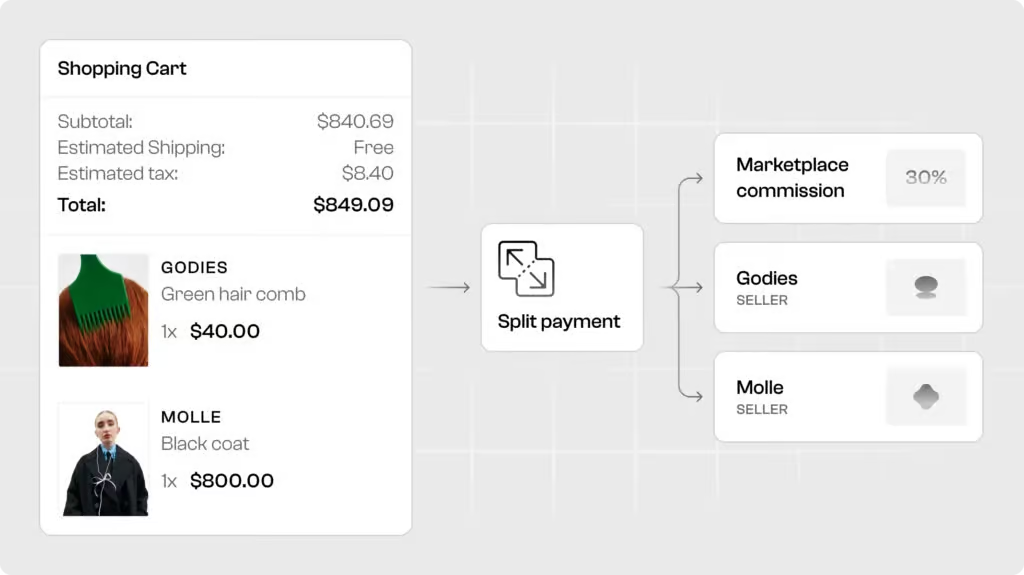
Building a Marketplace with Spree Commerce Open Source
For multi-vendor marketplaces, the flexibility and control offered by open-source solutions like Spree Commerce can be a significant competitive advantage. While SaaS platforms may offer quick setup, they often lack the customization capabilities needed to create truly unique and scalable marketplace experiences.
While SaaS solutions offer quick setup, they often lack the flexibility and customization capabilities required to create truly unique marketplace experiences. This is where Spree Commerce, an open-source e-commerce framework, shines. By choosing Spree, marketplace operators gain unprecedented control over their platform’s functionality, appearance, and scalability, all while maintaining full ownership of their code and data.
Companies like Wayfair, Newegg, Rakuten, Overstock, and Fruugo have successfully implemented multi-vendor marketplace models that demonstrate the potential of this e-commerce approach.
Key Benefits of Spree Open Source for Multi-Vendor Marketplaces
1. Rewards Marketplaces
Spree enables the creation of innovative rewards-based marketplaces:
- Example 1: A corporate incentive program where employees can redeem points earned through performance for products from various vendors.
- Example 2: A customer loyalty platform for a group of airlines, hotels, and car rental companies, allowing members to redeem points for physical products from multiple retailers.
- Example 3: A bank’s credit card rewards program, offering a marketplace where cardholders can redeem points for electronics, home goods, and other physical products from a diverse range of retailers.
2. Educational Platforms
Transform learning experiences with customizable educational marketplaces:
- Example 1: A platform for publishers to offer their digital textbooks and educational e-books to students and institutions.
- Example 2: A marketplace for educational materials where teachers can buy and sell digital resources like lesson plans, worksheets, and interactive learning modules.
- Example 3: A professional development platform where companies can purchase training materials, e-learning courses, and digital certifications for their employees.
3. Multi-Brand Product Marketplaces
Create diverse product marketplaces catering to various industries and niches:
- Example 1: A marketplace for artisanal and handcrafted physical products from independent makers worldwide.
- Example 2: A B2B marketplace for industrial equipment, connecting manufacturers with distributors and end-users.
- Example 3: A specialized marketplace for eco-friendly and sustainable physical products across various categories.
4. B2B Marketplaces
Facilitate business-to-business transactions with specialized features:
- Example 1: A raw materials marketplace connecting suppliers with manufacturers, featuring bulk ordering and custom pricing for physical goods.
- Example 2: A platform for wholesalers to offer their products to retailers, with features like minimum order quantities and tiered pricing for various consumer goods.
- Example 3: A marketplace for office supplies and equipment, where businesses can purchase everything from stationery to furniture from multiple vendors.
5. Hybrid Marketplaces
Combine different marketplace models to create unique platforms:
- Example 1: An automotive marketplace that allows manufacturers to sell vehicles directly to consumers while also offering aftermarket parts and accessories from third-party vendors.
- Example 2: A food industry marketplace where restaurants can purchase ingredients from suppliers and also offer meal kits or prepared foods to consumers.
- Example 3: A fashion marketplace that not only allows designers to sell their finished products but also connects them with fabric suppliers and offers digital fashion design tools.
Real-Life Examples of Multi-Vendor Marketplaces
Several companies have successfully implemented multi-vendor marketplace models that showcase the potential of this e-commerce approach:
- Wayfair: An online marketplace specializing in home goods and furniture, featuring products from thousands of suppliers.
- Newegg: A technology-focused e-commerce company that operates as a marketplace for computer hardware and consumer electronics.
- Rakuten: A Japanese e-commerce company that operates a large online marketplace with a wide variety of products from different sellers.
- Overstock: An American internet retailer selling a broad range of products, including furniture, home decor, and many other categories, sourced from numerous suppliers.
- Fruugo: A global marketplace that allows retailers to sell their products internationally, supporting multiple currencies and languages.
The Open-Source Advantage for Multi-Vendor Marketplaces
Choosing an open-source platform like Spree Commerce for multi-vendor marketplaces offers several key advantages over SaaS solutions:
- Unlimited Customization: Tailor every aspect of your marketplace to fit your unique business model and user experience vision.
- Scalability: Grow your platform without the constraints of SaaS tiers, handling increasing numbers of vendors and transactions seamlessly.
- Cost-Effectiveness: Eliminate per-transaction fees often associated with SaaS marketplace platforms, potentially saving significant amounts as your marketplace grows.
- Data Ownership: Maintain full control over your marketplace’s data, crucial for building trust with both vendors and customers.
- Integration Flexibility: Connect your marketplace with any third-party service or existing system without API limitations.
- Community Support: Benefit from a vast community of developers contributing improvements and extensions to the Spree ecosystem.
Conclusion
By choosing Spree Commerce open-source for their marketplace solution, businesses can build marketplaces that precisely match their vision and can evolve with changing market demands. In the competitive world of online marketplaces, this level of customization, coupled with full ownership and control of your platform, can be the key to attracting both vendors and customers, ultimately driving the success of your multi-vendor e-commerce venture.



